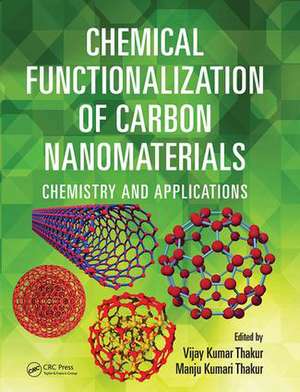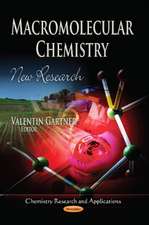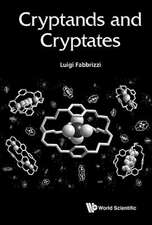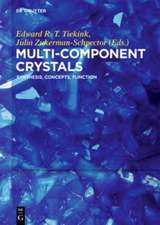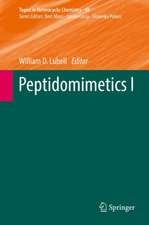Chemical Functionalization of Carbon Nanomaterials: Chemistry and Applications
Editat de Vijay Kumar Thakur, Manju Kumari Thakuren Limba Engleză Paperback – 24 ian 2018
The book covers modern techniques to characterize chemically functionalized carbon nanomaterials as well as characterization of surface functional groups. It includes contributions from international leaders in the field who highlight the multidisciplinary and interdisciplinary flexibility of functionalized carbon nanomaterials. The book illustrates how natural drawbacks to carbon nanomaterials, such as low solubility, can be countered by surface modifications and shows how to make modifications.
It discusses developments in the use of carbon nanomaterials in several critical areas in scientific research and practice, including analytical chemistry, drug delivery, and water treatment. It explores market opportunities due to the versatility and increasing applicability of carbon nanomaterials. It also gives suggestions on the direction of the field from its current point, paving the way for future developments and finding new applications.
Chemical Functionalization of Carbon Nanomaterials: Chemistry and Applications is a significant collection of findings in a rapidly developing field. It gives an in-depth look at the current achievements of research and practice while pointing you ahead to new possibilities in functionalizing and using carbon nanomaterials.
Preț: 552.60 lei
Preț vechi: 763.65 lei
-28% Nou
Puncte Express: 829
Preț estimativ în valută:
105.74€ • 113.07$ • 88.16£
105.74€ • 113.07$ • 88.16£
Carte tipărită la comandă
Livrare economică 17 aprilie-01 mai
Preluare comenzi: 021 569.72.76
Specificații
ISBN-13: 9781138894570
ISBN-10: 1138894575
Pagini: 1102
Dimensiuni: 210 x 280 x 52 mm
Greutate: 0.45 kg
Ediția:1
Editura: CRC Press
Colecția CRC Press
ISBN-10: 1138894575
Pagini: 1102
Dimensiuni: 210 x 280 x 52 mm
Greutate: 0.45 kg
Ediția:1
Editura: CRC Press
Colecția CRC Press
Cuprins
CHEMICAL FUNCTIONALIZATION OF CARBON NANOMATERIALS: STRUCTURE AND CHEMISTRY. Carbon Allotropes and Fascinated Nanostructures: The High-Impact Engineering Materials of the Millennium. Different Functionalization Methods of Carbon-Based Nanomaterials. Role of Top and Interlayer Metal Nanoparticle Grafting on CNTs: Improved Raman Scattering and Electron Emission Investigations. Overview on the Functionalization of Carbon Nanotubes. Collective Nature of Chemical Bonds in Fullerenes and Fullerites C60: Vibrational Resonances, Vibration-Electron Interactions, and Anomalous Enhancement of Bands in the Vibrational Spectra of Nanofilms (Results of Vibrational Spectroscopy and Quantum Chemical Calculations). Carbon Material-Supported Nanostructures in Catalytic Organic Transformations. Synthesis and Properties of Single-Walled Carbon Nanotubes Filled with Inorganic Compounds and Metals. Chemical Functionalization of Endohedral Metallofullerenes: Changes Caused from the Outside. Electrochemical Methods to Functionalize Carbon Materials. Surface Oxygen Functionalities and Microstructure of Activated Carbons Derived from Lignocellulosic Resources. Fluorescence Sensing by Functionalized Carbon Dots Nanoparticles. Aligned Carbon Nanotube-Based Sensing Materials. Density Functional Investigation on M3N@C80 and M2C2@C82 (M = Sc, Y). Modification of Polymer Membranes Using Carbon Nanotubes. Structures, Fabrication, Physical Properties, and Applications of Graphene Oxide and Hydrogenated Graphene. Click Functionalization of Carbon Nanotubes and Graphene with Polymers. Chemical Functionalization as an Approach for the Creation of Arrays of Graphene Quantum Dots Embedded in Dielectric Matrix. Sonochemical Preparation of Graphene Nanocomposites: Process Intensification. Graphene Plasmonics. Quantum Spin Hall Effect in Edge-Functionalized Graphene Nanoribbon. Functionalization Methods of Graphene. Functionalization of Carbon Nanotubes and Graphene with Amines and Biopolymers Containing Amino Groups. CHEMICAL FUCTIONALIZATION OF CARBON NANOMATERIALS: PROPERTIES AND APPLICATIONS. Applications of Functionalized Carbon-Based Nanomaterials. Chemical Functionalization of Carbon Materials and Its Applications. Carbon Nanotube Field-Effect Transistor: The Application of Carbon Nanotube. On the Mechanical Properties of Functionalized CNT Reinforced Polymer. Drug Delivery Aspects of Carbon Nanotubes. Surface Functionalization of Nanodiamond for Biomedical Applications: Polyglycerol Grafting and Further Derivatization. Applications of Functionalized Carbon-Based Nanomaterials in Analytical Chemistry. Surface Modifications of Carbon Nanotubes and Its Application in Environmental Protection. The Use of Carbon Nanotubes in the Treatment of Water and Wastewater. Application of Functionalized Carbon-Based Nanomaterials in Membrane Separation: Carbon Nanotubes and Graphene. Chemical Modification of Carbon Nanotubes/Nanofibers for Application in Cement and Concrete Field. Emerging Applications of Functionalized Carbon-Based Nanomaterials. Quantum Chemical Prospective of Open-Shell Carbon Nanomaterials for Nonlinear Optical Applications. Functionalization of Carbon Nanotubes with Polymers. Graphene: Functionalization with Nanoparticles and Applications. Recent Trends in Carbon Nanotubes/Graphene Functionalization for Gas/Vapor Sensing: A Review. Chemical Modification of Graphene for Optoelectronic Applications. Chemical Modification of Graphene and Applications for Chemical Sensors. Hysteresis in the Resistivity of Graphene Channel. Electronic and Optical Properties of Boron- and Nitrogen-Functionalized Graphene Nanosheet. CVD of Carbon Nanomaterials: From Graphene Sheets to Graphene Quantum Dots. Carbon Nanomaterials for Gas-Sensing Application. Nanocarbon Electron Emitters: Advances and Applications.
Notă biografică
Vijay Kumar Thakur, PhD, is a research faculty member in the School of Mechanical and Materials Engineering at Washington State University, Pullman, Washington. His research interests include the synthesis and processing of biobased polymers, nanomaterials, polymer micro-/nanocomposites, nanoelectronic materials, novel high dielectric constant materials, electrochromic materials for energy storage, green synthesis of nanomaterials, and surface functionalization of polymers/nanomaterials. He completed his postdoctorate in materials science and engineering at Iowa State University and earned his PhD in polymer chemistry at the National Institute of Technology. He has published more than 80 SCI journal research articles, 15 books, and 33 book chapters and holds one U.S. patent. He is an editorial board member of several international journal, serves as the regional editor for the journal Recent Patents on Materials Science, as academic editor for the British Journal of Applied Science & Technology, and is the guest editor for the Journal of Nanomaterials, International Journal of Polymer Science, Journal of Chemistry, and American Journal of Applied Chemistry.
Manju Kumari Thakur, MSc, MPhil, PhD, is an assistant professor of chemistry at the Division of Chemistry, Govt. Degree College Sarkaghat, Himachal Pradesh University, Shimla, India. She earned her BSc in chemistry, botany, and zoology, her MSc and MPhil in organic chemistry, and her PhD in polymer chemistry from the chemistry department at Himachal Pradesh University, Shimla. She has rich experience in the field of organic chemistry, biopolymers, composites/nanocomposites, hydrogels, applications of hydrogels in the removal of toxic heavy metal ions, and drug delivery. She has published more than 30 research papers in several international journals, coauthored five books, and 28 book chapters in the field of polymeric materials.
Manju Kumari Thakur, MSc, MPhil, PhD, is an assistant professor of chemistry at the Division of Chemistry, Govt. Degree College Sarkaghat, Himachal Pradesh University, Shimla, India. She earned her BSc in chemistry, botany, and zoology, her MSc and MPhil in organic chemistry, and her PhD in polymer chemistry from the chemistry department at Himachal Pradesh University, Shimla. She has rich experience in the field of organic chemistry, biopolymers, composites/nanocomposites, hydrogels, applications of hydrogels in the removal of toxic heavy metal ions, and drug delivery. She has published more than 30 research papers in several international journals, coauthored five books, and 28 book chapters in the field of polymeric materials.
Descriere
This book provides a thorough examination of the rapidly developing field of carbon-based nanomaterials. It covers important up-to-date research on carbon nanomaterials, including descriptions of their variants and how they can be chemically functionalized. It also gives an overview of current advanced applications of functionalized carbon nanomaterials, including their use in critical areas such as chemical analysis, drug delivery, and water treatment. It is a significant collection of findings that give an in-depth look at current achievements in the field while looking ahead to new possibilities in research and practice.
